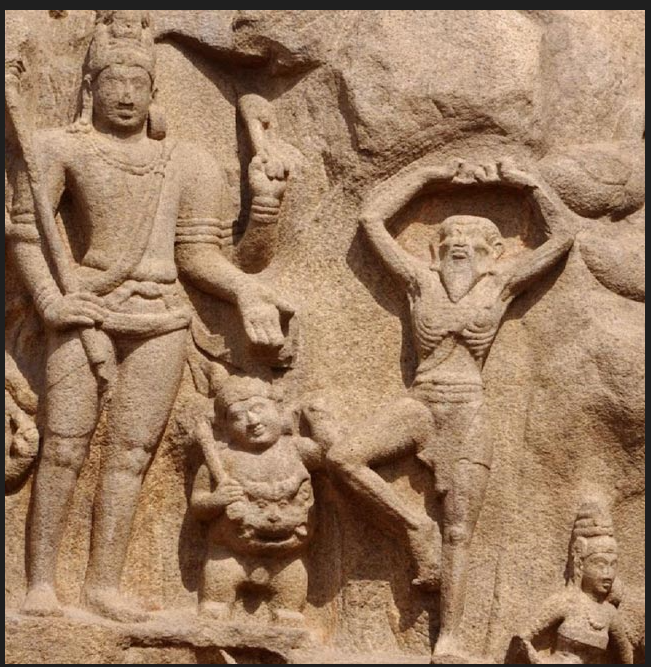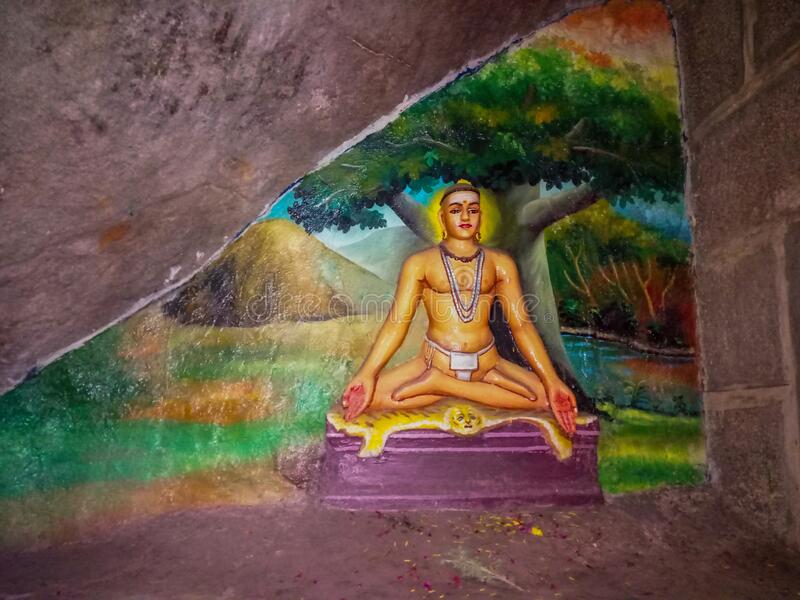Yoga of history is a set of physical, mental, and spiritual activities or disciplines that originated in ancient India that attempt to control (yoke) and rest the mind, identifying a detached witness-consciousness undisturbed by the mind (Chitta) and everyday grief (Dukha). There are different schools of yoga, practices, and goals in Hinduism, Buddhism, and Jainism, and both traditional and modern yoga are practiced worldwide.
Content Outline
Defining yoga:
In Indian philosophical and religious traditions, defining yoga the term yoga has been defined in a variety of ways (source: Yoga#History).
| Vaisesika Sutra | 4th century BCE | “The interaction of the sense organs, the mind, and objects produces pleasure and misery. When this does not happen, there is no joy or grief for an embodied person because the mind resides in the self. That’s how yoga functions.” |
| Katha Upanishad | last centuries BCE | “When the five senses, as well as the mind, are still and the intellect is not operating, this is the ultimate state. Yoga is seen by them as a strict control of the senses. Then, because yoga is emerging and passing away, one is un-distracted.” |
| Bhagavad Gita | 2nd century BCE | “Allow yourself to be surprised by both achievement and failure. Yoga is the word given to this state of serenity.” (2.48) “Yoga is a display of skill.” (2.50) “Be aware that what is referred to as yoga is the separation from sadness” (6.23). |
| Yoga Sutras of Patanjali | first centuries CE | “Yoga is the slowing down of mind fluctuations/patterns,” says 1.2. chitta vritti nirodhah. 1.3. The Seer’s essential and fundamental character is then established. 1.4. Assimilation (of the Seer) occurs in conjunction with changes in other states (of the mind). |
Yoga Theory
The origins of yoga can be divided into two categories. This worldview is primarily embraced by Hindu scholars, according to author Edward Fitzpatrick Crangle. According to the linear model, yoga has Vedic origins, as evidenced by the Vedic textual corpus, and was inspired by Buddhism. Yoga is a synthesis of indigenous, non-Vedic, and Vedic elements, according to the synthesis model; this paradigm is widely acknowledged in Western academics.
Yoga First Mentioned
Yoga is stated in various Hindu scriptures and was first mentioned in the Rigveda. The Katha Upanishad, which was most likely composed between the fifth and third centuries BCE, has the word “yoga” with the same meaning as the present term.
Throughout the fifth and sixth century BCE, yoga evolved as a systematic study and practice in ancient India’s ascetic and Sramaa movements. Yoga philosophy became recognized as one of Hinduism’s six orthodox philosophical schools (Darsanas) in the second century CE, when Patanjali’s Yoga Sutras, the most comprehensive treatise on Yoga, were written in the early years of the Common Era. Between the ninth and eleventh centuries, hatha yoga literature, which originated in tantra, began to emerge.
Related article: Vinyasa Yoga – What’s Vinyasa Flow Yoga
The meaning of the word yoga (Etymology)
The Sanskrit noun yoga is derived from the root yuj, which means “to attach, unite, harness, or yoke” in English. The word “yoga” comes from the English word “yoke.” The word “yoga” was originally employed in a hymn of the Rigveda, a worship to the rising Sun-god, where it was translated as “yoke” or “control,” according to Mikel Burley. [note]
The name yoga can be derived from one of two roots, according to Paini (th century BCE): yujir yoga (to yoke) or yuj samdhau (to yoke) (“to concentrate”). In the context of the Yoga Sutras, traditional interpreters feel that the root yuj samdhau (to concentrate) is the correct derivation.
Vyasa (the first commentator on the Yoga Sutras) explains that yoga means samadhi, according to Paini (concentration). Kriyyoga is a term used in the Yoga Sutras to describe yoga’s “practical” aspect: “connection with the ultimate” in daily actions. A yogi is a person who does yoga or believes in the idea of yoga with zeal; a female yogi is known as a yogini.
Yoga of history:
Yoga originate from which country? The origins of yoga are explained by two primary ideas. According to the linear model, yoga has Vedic origins (as evidenced by Vedic scriptures) and has influenced Buddhism. Hindu intellectuals are largely in favor of this model. Yoga is a synthesis of indigenous, non-Vedic traditions with Vedic elements, according to the synthesis model. In Western academia, this model is favored.
Related: Importance of Yoga 10 Points
Yoga was initially mentioned in the early Bhagavad Gita of the first millennium BCE, with expositions later appearing in Jain and Buddhist scriptures between 500 and 200 BCE. Traditions of Hindu, Buddhist, and Jain philosophy began to emerge between 200 BCE and 500 CE; teachings were collected as sutras, and a philosophical system known as Patanjaliyogasastra emerged. A number of yoga satellite traditions arose during the Middle Ages. During the mid-nineteenth century, it and other components of Indian philosophy were brought to the notice of the educated Western public.
Origination of yoga
Yoga’s origins can be traced back to northern India for over 5,000 years. Yoga was initially recorded in ancient religious texts such as the Rig Veda. The Vedas are a compilation of four sacred Sanskrit books that date back thousands of years.
Yoga is said to have been performed since the beginning of time. Yoga science has been around for thousands of years, even before the first religions or belief systems emerged. In yogic literature, Shiva is considered as the first yogi, or Adiyogi, as well as the first Guru, or Adi Guru.
Must read: Ashtanga Yoga
Linear model
According to Edward Fitzpatrick Crangle, Hindu researchers prefer a linear theory that tries “to interpret the origin and early development of Indian contemplative practices as a sequential growth from an Aryan genesis”;[note] traditional Hinduism considers the Vedas to be the source of all spiritual knowledge. Authors that accept Indigenous Aryanism, according to Edwin Bryant, also support the linear model.
Synthesis model
Heinrich Zimmer advocated for India’s non-Vedic eastern states as part of the synthesis model. Yoga is part of a non-Vedic system that includes the Samkhya school of Hindu philosophy, Jainism, and Buddhism, according to Zimmer: “[Jainism] does not derive from Brahman-Aryan sources but reflects the cosmology and anthropology of a much older pre-Aryan upper class of northeastern India [Bihar] – being rooted in the same subsoil of archaic metaphysical speculation as Yoga, Sank The Ramaa movement, according to Richard Gombrich and Geoffrey Samuel, began in non-Vedic Greater Magadha.
Sources
- History of Yoga: Yoga Book (Sri Ananda)
- The Origins of Yoga and Tantra (Geoffrey Samuel)











Your article gave me a lot of inspiration, I hope you can explain your point of view in more detail, because I have some doubts, thank you.
Your article gave me a lot of inspiration, I hope you can explain your point of view in more detail, because I have some doubts, thank you.
Your article gave me a lot of inspiration, I hope you can explain your point of view in more detail, because I have some doubts, thank you.
I am currently writing a paper and a bug appeared in the paper. I found what I wanted from your article. Thank you very much. Your article gave me a lot of inspiration. But hope you can explain your point in more detail because I have some questions, thank you. 20bet
Special offer for antibiotics: order cheap antibiotics without rx and get discount for all purchased! Two free pills (Viagra or Cialis or Levitra) available with every order. No prescription required, free delivery.
Thank you very much for sharing, I learned a lot from your article. Very cool. Thanks. nimabi
augmentin cost
Thank you very much for sharing, I learned a lot from your article. Very cool. Thanks. nimabi
Buy Amoxicillin Online – Special offer: Save up to $498 – buy antibiotics online and get discount for all purchased!
Your article helped me a lot, is there any more related content? Thanks! https://www.binance.com/lv/register?ref=IJFGOAID
Thank you for your sharing. I am worried that I lack creative ideas. It is your article that makes me full of hope. Thank you. But, I have a question, can you help me? https://accounts.binance.com/fr/register?ref=IJFGOAID
Your article helped me a lot, is there any more related content? Thanks! https://accounts.binance.com/de-CH/register?ref=OMM3XK51
buy baclofen 10 mg
Your point of view caught my eye and was very interesting. Thanks. I have a question for you. https://www.binance.info/sl/join?ref=RQUR4BEO
Thanks for sharing. I read many of your blog posts, cool, your blog is very good. https://www.binance.info/es/join?ref=WTOZ531Y
I don’t think the title of your article matches the content lol. Just kidding, mainly because I had some doubts after reading the article. https://accounts.binance.com/kz/register?ref=YY80CKRN
Can you be more specific about the content of your article? After reading it, I still have some doubts. Hope you can help me. https://www.binance.com/vi/register?ref=W0BCQMF1
Can you be more specific about the content of your article? After reading it, I still have some doubts. Hope you can help me. https://www.binance.info/sv/join?ref=V2H9AFPY
Cialis 5 Mg CuГЎnto Dura El Efecto
(Admin)
Cialis 5 mg prezzo cialis 5 mg prezzo cialis 5 mg prezzo
Your article helped me a lot, is there any more related content? Thanks! https://accounts.binance.com/ph/register-person?ref=GJY4VW8W
Срочно Продать BRAVIS Скупка
Your article helped me a lot, is there any more related content? Thanks! https://www.binance.com/sk/join?ref=WTOZ531Y
Hi there, everything is going well here and ofcourse every one is sharing facts, that’s genuinely excellent, keep up writing.
https://secure.squirtingvirgin.com/track/MzAxODgyLjUuMjguMjguMC4wLjAuMC4w
Today, while I was at work, my sister stole my iPad and tested to see if it can survive a 25 foot drop, just so she can be a youtube sensation. My iPad is now broken and she has 83 views. I know this is entirely off topic but I had to share it with someone!
https://tinyurl.com/SquirtCamweb
It’s amazing to go to see this web site and reading the views of all mates about this piece of writing, while I am also keen of getting know-how.
is cloudbet legal
zahry machinery equipment llc specializes in providing high-quality industrial equipment for a wide range of applications. We offer reliable solutions to meet the needs of our customers, ensuring their satisfaction with our products and services. Our company is committed to excellence and continuous improvement to better serve our customers.
Hi, everything is going well here and ofcourse every one is sharing information, that’s in fact fine, keep up writing.
best casinos online australia
Aviator Spribe играть на деньги казино
Should you tell it — a gross blunder.
Добро пожаловать в захватывающий мир авиаторов! Aviator – это увлекательная игра, которая позволит вам окунуться в атмосферу боевых действий на небе. Необычные графика и захватывающий сюжет сделают ваше путешествие по воздуху неповторимым.
Зарабатывайте деньги с автоматом Aviator Spribe играть и погрузитесь в азартное приключение!
Aviator игра позволит вам почувствовать себя настоящим пилотом. Вам предстоит совершить невероятные маневры, выполнять сложные задания и сражаться с противниками. Улучшайте свой самолет, чтобы быть готовым к любым ситуациям и становиться настоящим мастером.
Основные особенности Aviator краш игры:
1. Реалистичная графика и физика – благодаря передовой графике и реалистичной физике вы почувствуете себя настоящим пилотом.
2. Разнообразные режимы игры и миссии – в Aviator краш игре вы сможете выбрать различные режимы игры, такие как гонки, симулятор полетов и захватывающие воздушные бои. Кроме того, каждая миссия будет предлагать свои собственные вызовы и задачи.
3. Улучшение и модернизация самолетов – в игре доступны различные модели самолетов, которые можно покупать и улучшать. Вы сможете устанавливать новое оборудование, улучшать двигательность и мощность своего самолета, а также выбирать различные варианты окраски и декорации.
Aviator краш игра – это возможность испытать себя в роли авиатора и преодолеть все сложности и опасности воздушного пространства. Почувствуйте настоящую свободу и адреналин в Aviator краш игре онлайн!
Играйте в «Авиатор» в онлайн-казино Pin-Up
Aviator краш игра онлайн предлагает увлекательную и захватывающую игровую атмосферу, где вы становитесь настоящим авиатором и сражаетесь с самыми опасными искусственными интеллектами.
В этой игре вы должны показать свое мастерство и смекалку, чтобы преодолеть сложности многочисленных локаций и уровней. Вам предстоит собирать бонусы, уклоняться от препятствий и сражаться с врагами, используя свои навыки пилотирования и стрельбы.
Каждый уровень игры Aviator краш имеет свою уникальную атмосферу и задачи. Будьте готовы к неожиданностям, так как вас ждут захватывающие повороты сюжета и сложные испытания. Найдите все пути к победе и станьте настоящим героем авиатором!
Авиатор игра является прекрасным способом провести время и испытать настоящий адреналиновый разряд. Готовы ли вы стать лучшим авиатором? Не упустите свой шанс и начните играть в Aviator краш прямо сейчас!
Aviator – играй, сражайся, побеждай!
Aviator Pin Up (Авиатор Пин Ап ) – игра на деньги онлайн Казахстан
Aviator игра предлагает увлекательное и захватывающее разнообразие врагов и уровней, которые не оставят равнодушными даже самых требовательных геймеров.
Враги в Aviator краш игре онлайн представлены в самых разных формах и размерах. Здесь вы встретите группы из маленьких и быстрых врагов, а также огромных боссов с мощным вооружением. Разнообразие врагов позволяет игрокам использовать разные тактики и стратегии для победы.
Кроме того, Aviator игра предлагает разнообразие уровней сложности. Выберите легкий уровень, чтобы насладиться игровым процессом, или вызовите себе настоящий вызов, выбрав экспертный уровень. Независимо от выбранного уровня сложности, вы получите максимум удовольствия от игры и окунетесь в захватывающий мир авиаторов.
Играйте в Aviator и наслаждайтесь разнообразием врагов и уровней, которые позволят вам почувствовать себя настоящим авиатором.
Cialis Opiniones Mujeres
I apologise, but, in my opinion, you are mistaken. I can defend the position.
Cialis 5 mg prezzo tadalafil 5 mg prezzo tadalafil 5 mg prezzo
Thank you for sharing your thoughts. I really appreciate your efforts and I will be waiting for your next write ups thanks once again.
bcgame login
What’s up, its nice paragraph concerning media print, we all know media is a wonderful source of data.
booi casino darmowa kasa bez depozytu
Ваш надежный партнер Пункт приема Металла в Алматы Наша компания предлагает высококачественные услуги по приему, сортировке и переработке металлических отходов. Мы гарантируем прозрачные условия сотрудничества, конкурентоспособные цены и оперативное обслуживание.
Your article helped me a lot, is there any more related content? Thanks! https://www.binance.com/ru/join?ref=S5H7X3LP
This page truly has all of the info I needed concerning this subject and didn’t know who to ask.
http://www.google.bi/url?q=https://didvirtualnumbers.com/de/
Thanks for another magnificent post. Where else could anyone get that kind of information in such a perfect way of writing? I have a presentation next week, and I’m at the search for such information.
http://clients1.google.com.bo/url?q=https://hottelecom.biz/hi/
how much is valtrex generic
Aviator Spribe играть с бонусом казино
Добро пожаловать в захватывающий мир авиаторов! Aviator – это увлекательная игра, которая позволит вам окунуться в атмосферу боевых действий на небе. Необычные графика и захватывающий сюжет сделают ваше путешествие по воздуху неповторимым.
Aviator Spribe казино играть бесплатно
I don’t think the title of your article matches the content lol. Just kidding, mainly because I had some doubts after reading the article.
I’d like to find out more? I’d like to find out some additional information.
Rybelsus
This is very interesting, You are a very skilled blogger. I’ve joined your rss feed and look forward to seeking more of your excellent post. Also, I have shared your web site in my social networks!
Experimental Samples, Loops & Sounds
Wow, amazing blog layout! How long have you been blogging for? you made blogging look easy. The overall look of your web site is excellent, let alone the content!
writing service
Aviator Spribe казино играть на гривны
Добро пожаловать в захватывающий мир авиаторов! Aviator – это увлекательная игра, которая позволит вам окунуться в атмосферу боевых действий на небе. Необычные графика и захватывающий сюжет сделают ваше путешествие по воздуху неповторимым.
Aviator Spribe играть на доллары
Your point of view caught my eye and was very interesting. Thanks. I have a question for you.
Can you be more specific about the content of your article? After reading it, I still have some doubts. Hope you can help me.
Your point of view caught my eye and was very interesting. Thanks. I have a question for you.
Завод из России реализует разборные гантели gantel-razbornaya.ru – у нас найдете замечательный ассортимент вариантов. Наборные снаряды дают продуктивно выполнять силовые тренировки в любом месте. Изделия для спорта отличаются удобством, безопасностью в эксплуатации. Компания из России эффективно испытывает и внедряет инновационные технологии, чтобы реализовать желания постоянных покупателей. В изготовлении надежных снарядов активно используются высококлассные марки чугуна. Широкий каталог интернет-магазина вариантов позволяет приобрести разборные гантели для эффективной программы тренировок. Для домашних занятий – это приятный комплект с маленькими размерами и большой фунциональности.
Can you be more specific about the content of your article? After reading it, I still have some doubts. Hope you can help me.
Создаваемые торгово-промышленным объединением тренажеры для кинезитерапии https://trenazhery-dlya-kineziterapii.ru и специально созданы для восстановления после травм. Конструкции имеют выгодное предложение стоимости и функциональности.
Предлагаем очень доступно Кроссовер с усиленной конструкцией. В каталоге интернет-магазина для кинезитерапии всегда в продаже модели блочного и нагружаемого типа.
Изготавливаемые тренажеры для реабилитации обеспечивают комфортную и безопасную тренировку, что особенно важно для пациентов в процессе восстановления.
Станки обладают регулируемым сопротивлением и уровнями нагрузки, что дает возможность индивидуализировать занятия в соответствии с задачами любого пациента.
Все тренажеры подходят для кинезитерапии по руководству врача физиотерапевта Сергея Бубновского. Оборудованы рукоятками для удобного осуществления тяг в наклоне или лежа.
Hi there i am kavin, its my first occasion to commenting anywhere, when i read this piece of writing i thought i could also create comment due to this brilliant article.
https://dominicklmmj95050.ziblogs.com/25781046/seamless-integration-optimum-performance-renting-a-contact-number-with-hottelecom
Условия и правила предоставления услуг доставки.
Wow, superb weblog format! How lengthy have you ever been blogging
for? you made blogging glance easy. The whole look of your web
site is wonderful, let alone the content! You can see similar here e-commerce
ラブドール 浴室のセックスは選択された位置を持っていますセックス人形で遊んでみませんか?時間の女性はJY人形5ft5170cmのために白い巨大なおっぱいにいました
Discover the power of privacy with TornadoCash! Learn how this decentralized mixer ensures your transactions remain confidential.
Your point of view caught my eye and was very interesting. Thanks. I have a question for you.
I don’t think the title of your article matches the content lol. Just kidding, mainly because I had some doubts after reading the article.
В нашем мире, где диплом – это начало успешной карьеры в любой сфере, многие стараются найти максимально простой путь получения образования. Важность наличия официального документа об образовании переоценить невозможно. Ведь именно диплом открывает двери перед всеми, кто хочет начать профессиональную деятельность или учиться в университете.
В данном контексте наша компания предлагает быстро получить любой необходимый документ. Вы имеете возможность приобрести диплом, и это будет удачным решением для всех, кто не смог завершить образование или потерял документ. диплом изготавливается с особой тщательностью, вниманием к мельчайшим элементам, чтобы в итоге получился документ, 100% соответствующий оригиналу.
Плюсы этого подхода состоят не только в том, что можно максимально быстро получить диплом. Процесс организовывается удобно, с профессиональной поддержкой. От выбора нужного образца документа до консультации по заполнению личной информации и доставки по России — все находится под полным контролем качественных специалистов.
Для всех, кто ищет максимально быстрый способ получить требуемый документ, наша компания предлагает выгодное решение. Заказать диплом – значит избежать длительного обучения и не теряя времени переходить к личным целям, будь то поступление в ВУЗ или начало удачной карьеры.
https://diploman-russiyans.com
В современном мире, где диплом становится началом отличной карьеры в любой сфере, многие ищут максимально простой путь получения образования. Факт наличия официального документа переоценить невозможно. Ведь диплом открывает дверь перед любым человеком, который собирается начать трудовую деятельность или учиться в ВУЗе.
Наша компания предлагает оперативно получить этот необходимый документ. Вы можете заказать диплом, и это является отличным решением для всех, кто не смог закончить обучение или потерял документ. дипломы изготавливаются с особой тщательностью, вниманием к мельчайшим нюансам, чтобы в итоге получился документ, максимально соответствующий оригиналу.
Преимущества такого решения состоят не только в том, что можно оперативно получить диплом. Процесс организован удобно, с нашей поддержкой. От выбора нужного образца диплома до консультаций по заполнению персональной информации и доставки по стране — все под полным контролем квалифицированных специалистов.
Всем, кто пытается найти быстрый способ получения требуемого документа, наша компания предлагает выгодное решение. Приобрести диплом – значит избежать продолжительного обучения и сразу переходить к важным целям, будь то поступление в университет или старт профессиональной карьеры.
https://diploman-russiyans.com
В наше время, когда диплом становится началом удачной карьеры в любой сфере, многие стараются найти максимально быстрый и простой путь получения образования. Факт наличия официального документа трудно переоценить. Ведь диплом открывает двери перед людьми, стремящимися начать трудовую деятельность или продолжить обучение в университете.
В данном контексте наша компания предлагает максимально быстро получить этот необходимый документ. Вы можете заказать диплом нового или старого образца, и это будет выгодным решением для всех, кто не смог завершить образование, потерял документ или желает исправить свои оценки. Любой диплом изготавливается с особой тщательностью, вниманием к мельчайшим нюансам, чтобы в результате получился продукт, максимально соответствующий оригиналу.
Плюсы такого подхода заключаются не только в том, что вы оперативно получите свой диплом. Весь процесс организовывается комфортно и легко, с нашей поддержкой. Начав от выбора требуемого образца до грамотного заполнения персональных данных и доставки по России — все будет находиться под абсолютным контролем качественных мастеров.
Всем, кто ищет оперативный способ получить необходимый документ, наша услуга предлагает отличное решение. Заказать диплом – это значит избежать долгого процесса обучения и сразу переходить к достижению своих целей: к поступлению в университет или к началу трудовой карьеры.
https://dlplomanrussian.com
В современном мире, где диплом – это начало отличной карьеры в любом направлении, многие ищут максимально быстрый и простой путь получения качественного образования. Наличие официального документа об образовании переоценить попросту невозможно. Ведь диплом открывает дверь перед людьми, стремящимися начать трудовую деятельность или учиться в высшем учебном заведении.
Наша компания предлагает быстро получить этот необходимый документ. Вы имеете возможность приобрести диплом нового или старого образца, и это является выгодным решением для человека, который не смог завершить обучение, потерял документ или желает исправить свои оценки. дипломы выпускаются с особой аккуратностью, вниманием к мельчайшим элементам, чтобы в результате получился 100% оригинальный документ.
Превосходство подобного подхода состоит не только в том, что вы сможете быстро получить диплом. Весь процесс организован комфортно, с нашей поддержкой. От выбора необходимого образца документа до правильного заполнения персональных данных и доставки в любой регион России — все под абсолютным контролем опытных мастеров.
Всем, кто хочет найти быстрый и простой способ получить необходимый документ, наша компания предлагает выгодное решение. Приобрести диплом – это значит избежать долгого обучения и не теряя времени переходить к своим целям, будь то поступление в университет или старт успешной карьеры.
https://diplomanc-russia24.com
В нашем мире, где диплом становится началом удачной карьеры в любом направлении, многие ищут максимально быстрый и простой путь получения образования. Необходимость наличия документа об образовании трудно переоценить. Ведь именно он открывает дверь перед всеми, кто стремится вступить в профессиональное сообщество или продолжить обучение в высшем учебном заведении.
Наша компания предлагает максимально быстро получить этот важный документ. Вы сможете приобрести диплом нового или старого образца, и это становится отличным решением для всех, кто не смог завершить образование или потерял документ. Все дипломы изготавливаются аккуратно, с максимальным вниманием ко всем элементам. В результате вы получите 100% оригинальный документ.
Плюсы такого решения заключаются не только в том, что вы сможете максимально быстро получить диплом. Весь процесс организован комфортно, с нашей поддержкой. От выбора подходящего образца документа до консультации по заполнению персональных данных и доставки по России — все будет находиться под абсолютным контролем качественных мастеров.
Всем, кто пытается найти быстрый и простой способ получения требуемого документа, наша компания предлагает выгодное решение. Приобрести диплом – это значит избежать долгого обучения и сразу переходить к своим целям, будь то поступление в университет или старт удачной карьеры.
https://diplomanc-russia24.com
В современном мире, где диплом – это начало отличной карьеры в любом направлении, многие ищут максимально быстрый и простой путь получения образования. Факт наличия официального документа трудно переоценить. Ведь именно диплом открывает двери перед людьми, желающими начать трудовую деятельность или продолжить обучение в высшем учебном заведении.
В данном контексте мы предлагаем быстро получить этот важный документ. Вы можете купить диплом нового или старого образца, и это становится удачным решением для всех, кто не смог завершить образование или утратил документ. Любой диплом изготавливается аккуратно, с особым вниманием ко всем деталям, чтобы в итоге получился документ, 100% соответствующий оригиналу.
Превосходство данного решения заключается не только в том, что вы оперативно получите свой диплом. Процесс организован удобно, с профессиональной поддержкой. От выбора требуемого образца диплома до грамотного заполнения личной информации и доставки по стране — все находится под абсолютным контролем наших мастеров.
В итоге, для всех, кто ищет быстрый и простой способ получить необходимый документ, наша компания предлагает выгодное решение. Приобрести диплом – значит избежать долгого процесса обучения и сразу переходить к своим целям, будь то поступление в университет или начало удачной карьеры.
https://diploman-russiyan.com
The other day, while I was at work, my cousin stole my iPad and tested to see if it can survive a 30 foot drop, just so she can be a youtube sensation. My iPad is now broken and she has 83 views. I know this is completely off topic but I had to share it with someone!
https://allmylinks.com/agentstvo-razvlecheniy
Thanks , I’ve just been looking for info approximately this topic for a long time and yours is the greatest I have came upon so far. But, what in regards to the conclusion? Are you sure in regards to the source?
https://tagoverflow.stream/story.php?title=SKLO-DLYA-FAR-EFEKTIVNII-ZAKHIST-%D1%96-STILNII-VIGLYAD#discuss
Hi there! This is my first comment here so I just wanted to give a quick shout out and tell you I genuinely enjoy reading your articles. Can you suggest any other blogs/websites/forums that cover the same subjects? Thanks a ton!
https://blogfreely.net/abbotsoutm/h1-b-osoblivosti-ta-perevagi-kupivli-skla-far-u-farfarlight-b-h1-833q
Since the admin of this website is working, no uncertainty very quickly it will be renowned, due to its feature contents.
https://open.substack.com/pub/simonzvzr117/p/bf6?r=3ts7ef&utm_campaign=post&utm_medium=web&showWelcomeOnShare=true
Как купить диплом легально
купить диплом Вуза http://www.diplom-msk.ru/ .
Hi to all, the contents existing at this web site are really amazing for people knowledge, well, keep up the nice work fellows.
https://anidub.org/